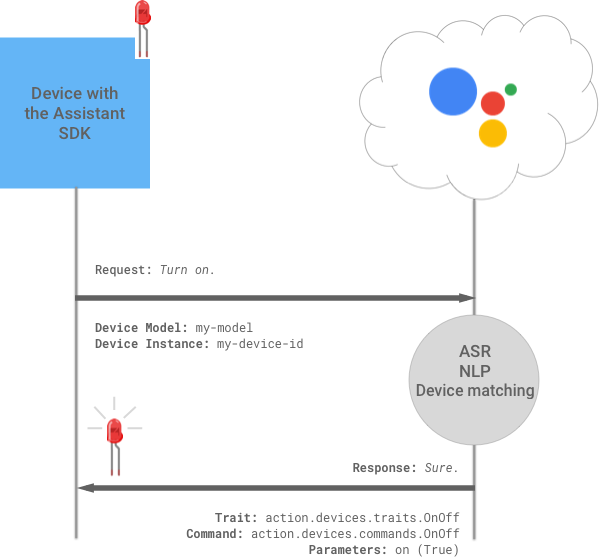باستخدام حزمة تطوير البرامج (SDK) من "مساعد Google"، يمكنك تضمين "مساعد Google" في مشروعك الخاص، ما يجعله يعمل بشكل مشابه لجهاز Google Home. ومع ذلك، قد يتضمّن مشروعك إمكانات فريدة للأجهزة لا تتوفّر في Google Home، مثل شاشة LED فريدة مع إعدادات قابلة للتخصيص للسطوع والألوان.
"إجراءات الجهاز" هي مجموعة من الأدوات وواجهات برمجة التطبيقات التي تتيح لك توسيع نطاق ما يمكن أن يفعله "مساعد Google" في المشاريع التي تطوّرها، وذلك للاستفادة إلى أقصى حد من إمكانات الأجهزة.
إجراءات الأجهزة المدمجة
أنشأت Google مجموعة كبيرة من الإجراءات الشائعة المضمّنة في الأجهزة لتنفيذ المهام اليومية، بما في ذلك الإضاءة والأجهزة والكاميرات. باستخدام هذه الإجراءات، يمكنك الاستفادة من إمكانات معالجة اللغة الطبيعية التي يوفّرها "مساعد Google" للتحكّم في مشروعك. على سبيل المثال، يمكن تشغيل مشروع يتضمّن مصباحًا بطرق مختلفة:
- Ok Google، أريد إضاءة المصباح.
- Ok Google، أريد إضاءة المصباح.
- Ok Google، أريد تشغيل الإضاءة في غرفة المعيشة.
يمكنك إنشاء مشروعك الخاص الذي يستجيب للأوامر الخاصة بالعديد من سمات المنزل الذكي مثل:
- Ok Google، أريد ضبط مستوى السطوع على %50.
- Ok Google، أريد ضبط درجة الحرارة على 37 درجة.
إجراءات الجهاز المخصّصة
يمكنك أيضًا إنشاء إجراءات مخصّصة للأجهزة لتناسب أجهزتك الفريدة. بالنسبة إلى هذه الإجراءات، عليك تحديد قواعد اللغة والأوامر:
- Ok Google، أريد أن يومض المصباح 5 مرات.
- Ok Google، انتقِل إلى اليسار.
مزيد من المعلومات حول دمج هذه الإجراءات باستخدام خدمة "مساعد Google"
آلية العمل
يجب أن يكون الجهاز مثبّتًا عليه حزمة تطوير البرامج (SDK) الخاصة بـ "مساعد Google"، بالإضافة إلى بيانات الاعتماد اللازمة للوصول إلى خدمة "مساعد Google". يرسل الجهاز الطلب الشفهي (فعِّل المصباح.) ويطلب من الخدمة تفعيل مصباح LED المدمج في الجهاز. يرسل الجهاز أيضًا معرّفات الطراز ومثيل الجهاز لكي تتمكّن الخدمة من تحديد أفضل طريقة للردّ على الطلب في سياقه.
تستخدم الخدمة ميزة "التعرّف التلقائي على الكلام" (ASR) لتحديد الكلمات التي نطق بها المستخدم، وميزة "معالجة اللغات الطبيعية" (NLP) لتحليل معنى الطلب وفهمه من هذه الكلمات، وميزة "مطابقة الأجهزة" لتوفير سياق للطلب. هذا السياق مهم لأنه يحدّد الإجراءات التي يتيحها الجهاز وكيفية تنفيذ هذه الإجراءات.
بعد ذلك، تردّ الخدمة بنص يتم نطقه للمستخدم (حسنًا) إلى جانب الأمر الخاص بالجهاز. يعرف الجهاز كيفية التعامل مع هذا الأمر، إذ يفعّل ضوء LED.

البدء
يمكنك تحويل أفكارك إلى واقع من خلال تضمين "مساعد Google" في مشروعك، ثم إضافة وظائف فريدة باستخدام "إجراءات الأجهزة". يمكنك تطوير مشروعك باستخدام خدمة "مساعد Google".

